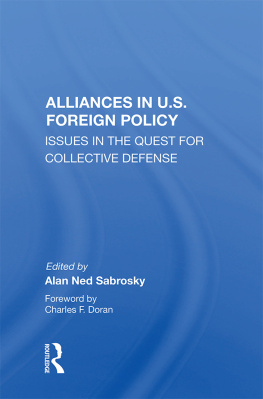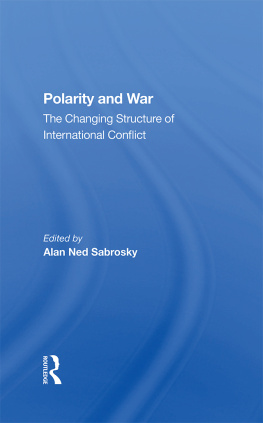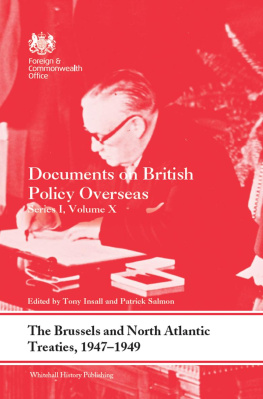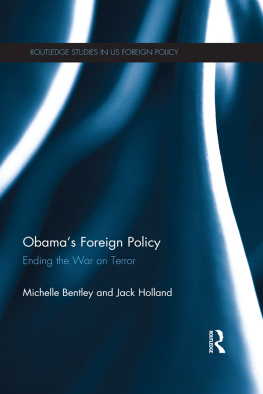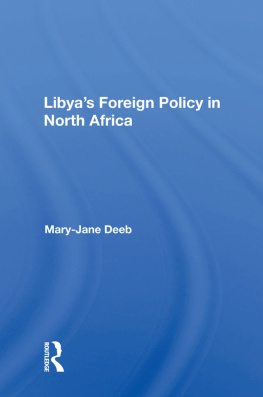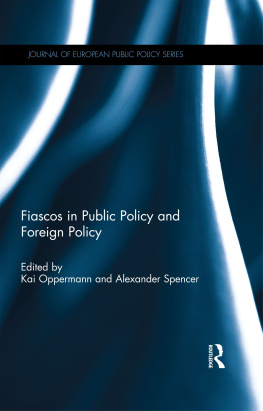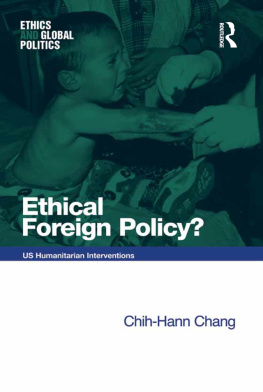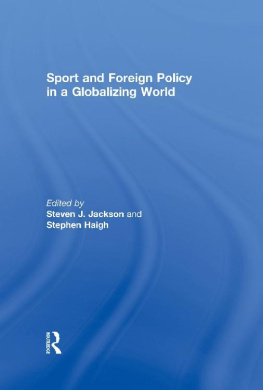ALLIANCES IN U.S. FOREIGN POLICY
First published 1988 by Westview Press, Inc.
Published 2018 by Routledge
52 Vanderbilt Avenue, New York, NY 10017
2 Park Square, Milton Park, Abingdon, Oxon OX14 4RN
Routledge is an imprint of the Taylor & Francis Group, an informa business
Copyright 1988 Taylor & Francis
All rights reserved. No part of this book may be reprinted or reproduced or utilised in any form or by any electronic, mechanical, or other means, now known or hereafter invented, including photocopying and recording, or in any information storage or retrieval system, without permission in writing from the publishers.
Notice:
Product or corporate names may be trademarks or registered trademarks, and are used only for identification and explanation without intent to infringe.
Library of Congress Cataloging-in-Publication Data
Alliances in U.S. foreign policy.
(Studies in global security)
Includes index.
1. United StatesForeign relations1981 .
2. Alliances. 3. North Atlantic Treaty Organization.
I. Sabrosky, Alan Ned. 1941 . II. Title: Alliances
in U.S. foreign policy. III. Series.
E876.A46 1988 327.73 86-4039
ISBN 13: 978-0-367-00579-5 (hbk)
Charles F. Doran
Analysis contained in these essays requires at the outset twofold comment. First, while policy-oriented and deeply relevant to the ongoing debate concerning alliance relations, these essays are informed both by international political theory and by an empirical familiarity with world and U.S. domestic politics. Although the mix varies from essay to essay, the combination of theory and empirical analysis provides a solid historical base for policy generalization. Policy analysis thus springs from more than the last newspaper account of events, while sacrificing nothing in terms of relevancy.
Second, the authors contributing to this volume represent a new generation of mature scholarship in the United States. Neither the Great Depression nor World War II are events with which many of these authors are personally familiar. The European Community, the great postwar alliance systems, and the Cold War are the givens of world politics which they have known personally and which provide background for their analysis, minus an identification with the turbulence that made the "givens" reality. One event, the Vietnam War, is perhaps freshest in their awareness. Assumptions regarding America's wealth are also different from the prior generation of writers who believed that demand-led economics could underpin every defense need. Also, unlike some of the writers in the 1970s who feared too much growth, many of these authors fear that there will be too little. Yet these writers are not so much easily categorized ideologically or in partisan terms, as they are pragmatic and prepared to ask questions requiring answers that go to the premises of alliance thought as much as to tactics or to the manner of implementation.
Thus, in approach to analysis and in terms of personal experience and mindset, these authors represent something new in the discussion f alliance politics. Despite arriving at different conclusions about its impact, these authors are perhaps responding to a common, sometimes implicit theoretical proposition about alliance participation and therefore about the determinants of alliance cohesion. The proposition reads something like this:
To what extent does participation in an alliance increase foreign policy benefits through enhancing one's own security and through reducing one's own probability of getting involved in war, and to what extent does participation decrease those benefits through entanglement in wars, precipitated by allies, that serve to undermine one's own security and increase one's own frequency or intensity of war involvement?
Alliances are therefore seen as manifesting both collective and noncollective goods. Neither peace nor security is seen as totally indivisible. Or, at the least, peace and security are contributed to unevenly and may, in some cases, provide selective benefits and costs. Greece does not contribute the same amount of resources to NATO as Britain. While each may provide a common defense against Soviet aggression, the differential risk that each will drag other alliance members into third-party conflicts may also be a factor that the other alliance members inevitably will use to condition their own participation.
Even the primary alliance focus involving the Soviet threat may be at issue if an alliance member thinks that it somehow could escape the consequences of attack by opting out of the alliance. Or the primary focus may be at issue if the state feels it is likely to gain less in security terms than it risks in associating with another alliance member that acts precipitously toward the Soviet Union and thus invites a challenge to the alliance as a whole. All of these calculations amount to dangerous thinking as regards alliance health. Moreover, it is only the mutuality and magnitude of external threat that prevent such thought from becoming debilitating for an alliance as a whole.
Historical empirical evidence shows, according to Alan Sabrosky, that when faced with the test of war, most alliance members have tended to stand aside or remain neutral. This is one of the most seminal discoveries in the empirical literature for policy. Along with the free rider effect expounded by Olson and Zeckhouser, it is one of the two most pregnant empirical findings to date concerning alliance behavior. Sabrosky also concludes that the "American system of alliances is now more entangling than it is supportive of American interests" and that NATO is "far more precarious than its advocates would have us believe." He thus urges caution when drawing conclusions about the responsiveness of alliance performance.
In a brilliant assessment of the implications for alliance cohesion of changing deterrent policy and the technical response to those changes, Earl Ravenal is not surprised by the questions raised by Europeans about the credibility of extended deterrence nor by the American shift toward defensive doctrine and the Strategic Defense Initiative. He finds the notion that Americans would sacrifice their cities in an attempt to defend Western Europe from Soviet occupation as problematic, just as he views SDI as an attempt to meet the European demand for a more perfect deterrent that would restore the American edge. But SDI, even if operable in some mode and cost-effective, may create problems of its own with respect to technical stability. His doubts regarding the plausibility of extended deterrence are only compounded by his doubts regarding the continuing American economic capacity to pay disproportionate costs of defense under present alliance terms.
Each of these challenges to traditional alliance thought require a far-reaching rebuttal. Some of the responses to these challenges emerge from the other essays appearing in this volume. For example, James O'Leary asserts that new coproduction arrangements between firms on each side of national boundaries are beginning to surmount protectionist pressures, thus reducing friction between allies. The shift of economic power towards Asia is also beginning to integrate U.S. security policy more closely with some of the NICs and Japan and to obtain from them somewhat larger contributions to their own defense. Likewise, according to Karen McPherson, divergent options within NATO are often more the result of differing domestic priorities among the member nations than of "inherent weakness" in the alliance itself. Gregory Foster maintains that public opinion is the fulcrum of alliance cohesion. While he laments the "gulf" that presently separates public opinion on both sides of the Atlantic and among the European allies themselves, he prescribes the formulation of a NATO public opinion strategy of the sort favored by Grethe Vaerno (Norwegian parliamentary member) stressing public diplomacy and employing propaganda, information, and cultural exchange.

